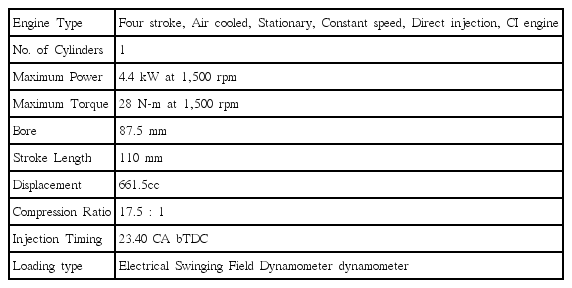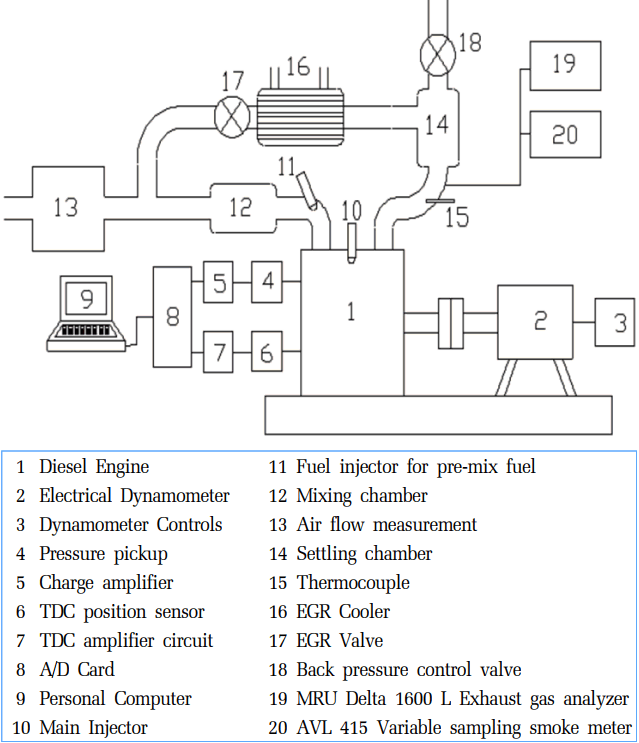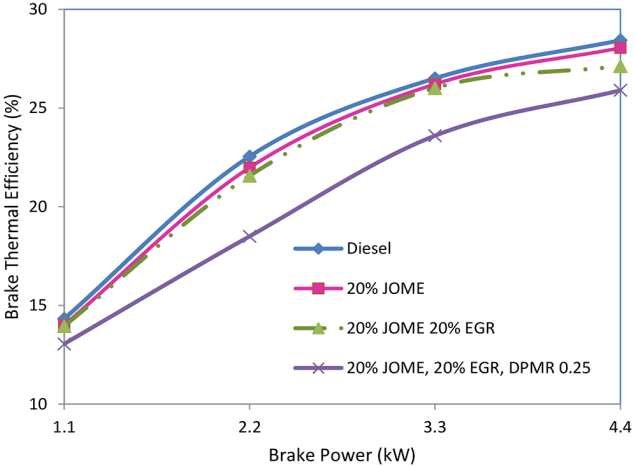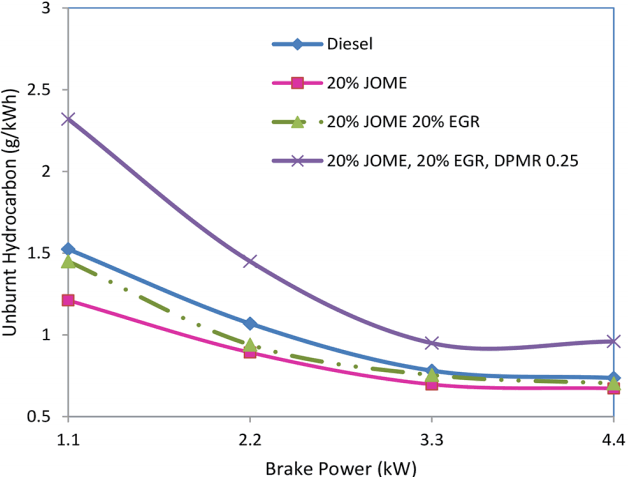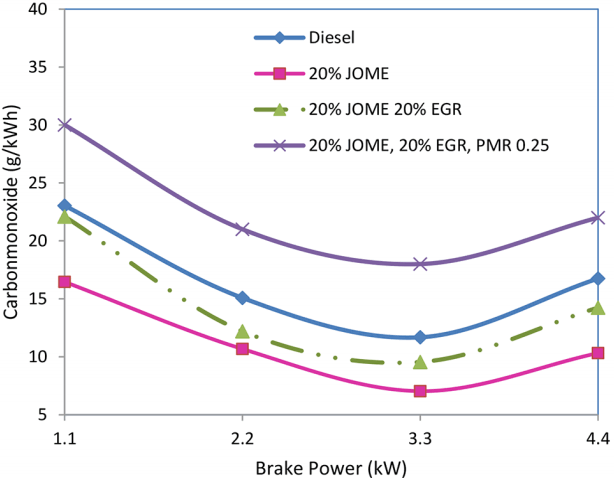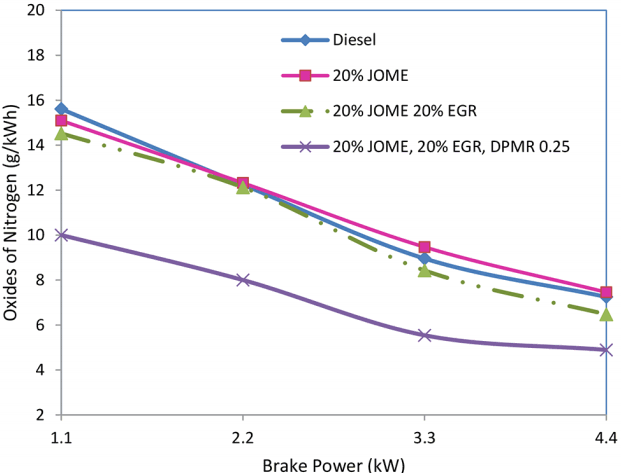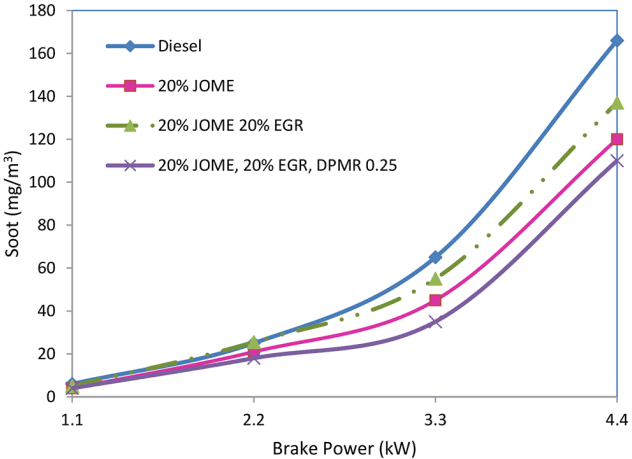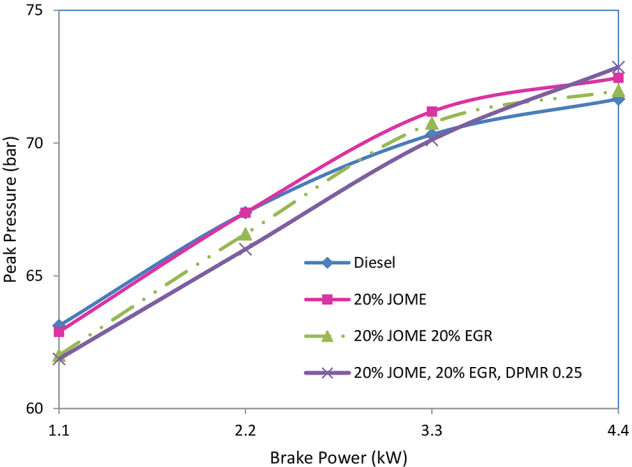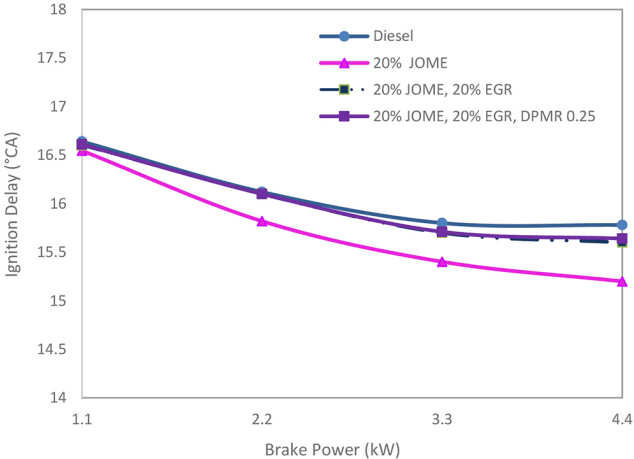Performance and emission characteristics of biodiesel blends in a premixed compression ignition engine with exhaust gas recirculation
Article information
Abstract
This paper is based on experiments conducted on a stationary, four stroke, naturally aspirated air cooled, single cylinder compression ignition engine coupled with an electrical swinging field dynamometer. Instead of 100% diesel, 20% Jatropha oil methyl ester with 80% diesel blend was injected directly in engine beside 25% pre-mixed charge of diesel in mixing chamber and with 20% exhaust gas recirculation. The performance and emission characteristics are compared with conventional 100% diesel injection in main chamber. The blend with diesel premixed charge with and without exhaust gas recirculation yields in reduction of oxides of nitrogen and particulate matter. Adverse effects are reduction of brake thermal efficiency, increase of unburnt hydrocarbons (UBHC), carbon monoxide (CO) and specific energy consumption. UBHC and CO emissions are higher with Diesel Premixed Combustion Ignition (DPMCI) mode compared to compression ignition direct injection (CIDI) mode. Percentage increases in UBHC and CO emissions are 27% and 23.86%, respectively compared to CIDI mode. Oxides of nitrogen (NOx) and soot emissions are lower and the percentage decrease with DPMCI mode are 32% and 33.73%, respectively compared to CIDI mode.
1. Introduction
Energy is a requirement in our everyday life as a way of improving human development leading to economic growth and productivity. The return-to-renewables will help mitigate climate change is an excellent way but needs to be sustainable to ensure a sustainable future for generations to meet their energy needs. Knowledge regarding the interrelations between sustainable development and renewable energy is still limited [1]. Economic and societal development of any nation depends very much on the availability of energy sources [2]. Energy sources are essential input in the areas of any production, but unfortunately the energy sources available are not only limited in volume and quality but also whatever is available are fast getting depleted, storing is necessary for mankind to develop non-conventional sources of energy that not only fulfills the demand but also at the same time keeps the environment clean or green [3]. Biodiesel takes its place as the most promising alternative fuel because of its renewability and sustainability. Biodiesel is made from rechargeable a natural resource that does not produce harmful byproducts. Biodiesel can be obtained from various sources like vegetable oils, recycled cooking oil, animal fats and algae, which are cost efficient and easy to make and use. Bio-diesel derived from edible, non-edible oils and animal fats can be used in diesel engines with little or no modifications [4].
Homogeneous Charge Compression Ignition (HCCI) is a promising alternative combustion technology for diesel engines with high efficiency and lower NOx and particulate matter emissions. Relative to compression ignition direct ignition engines, HCCI engines have substantially lower emissions [5–8]. The low emissions of particulate matter (PM) and NOx in HCCI engines are a result of the lean homogeneous air and fuel mixture in addition to low combustion temperatures. The charge in HCCI engine may be made lean by stratification, or with exhaust gas recirculation (EGR), or combination of these methods [9]. HCCI engines yield significant advantages but there are certain adverse effects such as the operating range of automotive engine using HCCI mode is found to be too narrow [10], improper combustion or misfire attributed to lean fuel mix limits the minimum power output at which the engine can operate and auto-ignition is difficult to control [11]. In literature, the HCCI combustion mode has different names: PPCCI (Partially Premixed Charge Compression Ignition), PCIC (Premixed Compression Ignited Combustion), HCDC (Homogeneous Charge Diesel Combustion) [12–14].
2. Premixed Compression Ignition (PMCI)
Experimental investigation has been done to study the effect of Premixed Compression Ignition (PMCI) mode; in this method, two fuels are used. One fuel is injected in to the intake air, upstream of the intake valve to obtain a premixed charge. Remaining fuel is injected into the combustion chamber directly by conventional injection system. This technique reduces NOx and PM and thereby reduction of air pollution. It is observed that extensive research is yet to be done on the usage of bio-diesel in PMCI mode; hence an investigation is conducted to study the effect of Jatropha oil methyl ester (JOME) biodiesel as main fuel and diesel as premixed fuel.
In PMCI, combustion takes place predominantly in a premixed manner than in a diffusive manner due to homogeneous nature of the premix [15]. Moreover, with premix charge, the combustion process occurs much faster than conventional Diesel combustion, as it occurs at multiple points in the cylinder [16]. This rapid combustion causes a sharp increase in pressure and temperature inside the engine. Therefore, in PMCI lean fuel-air mixture is used to maintain the temperature and pressure low in the cylinder and this restricts the usage to low loads.
Miao et al. [17] conducted experiments to investigate the effect of EGR on combustion and emission characteristics of a direct injection diesel engine. The increase of the EGR percentage resulted in longer ignition delay and the combustion shifted to a later stage while the combustion duration was reduced. Regarding the effect of EGR on the exhaust gaseous emissions, it reduces NOx emissions but increases other gaseous emissions. NOx emissions could be reduced significantly, whereas the smoke emission presents a sharp increase when the EGR ratio increases.
Reduced oxygen available for combustion lowers the effective air-fuel ratio. This effective reduction in air-fuel ratio affects exhaust emissions substantially [18, 19]. Mixing of exhaust gases increases specific heat results in the reduction of flame temperature. Thus combination of lower oxygen quantity in the intake air and reduced flame temperature reduces the rate of NOx formation reactions [20, 21]. The engines using EGR emit lower quantity of exhaust gases compared to non-EGR engines because part of the exhaust gas is re-circulated [22]. Kusaka et al. [23] also found that at low loads, EGR combined with intake heating can favorably reduce hydrocarbon emission with improvement in thermal efficiency. EGR was also used in a direct injection spark ignition engine as an effective way for improving fuel economy [24, 25].
Das et al. [26] used EGR to reduce NOx emissions in hydrogen–supplemented SI engine without any undesirable combustion phenomena. However, the use of EGR leads to a trade-off in terms of soot emissions moreover it exhausted more unburned hydrocarbons (20–30%) compared to conventional engines [27]. Therefore, in this work 20% EGR was used to study the performance with JOME blend with diesel.
Aoyama et al. [28] revealed that the engine operation was stable in the air fuel ratio range of 33–44 and significantly lower NOx emission compared with diesel engine. Suzuki [29] studied homogeneous charge compression ignition diesel combustion system and reported that smoke and NOx emissions decreased but HC, CO emissions increased as the pre-mixed ratio was increased. Kimura et al. [30] developed a new combustion concept, called modulated kinetics which reduced NOx and smoke simultaneously due to low-temperature and premixed combustion characteristics, respectively.
Torregrosa et al. [31] analyzed experimentally PCCI combustion with two injections (pilot and main) resulted in a significant reduction in emissions of NOx due to the use of high EGR rate which reduced in-cylinder oxygen content and subsequently combustion temperature. Saxena and Bedoya [32] reviewed HCCI operation which emphasis on the high load conditions and emissions characteristics and concluded that significant benefits of HCCI was that it can achieve efficiency levels and low CO2 comparable with diesel engines.
Kiplimo et al. [33] investigated the effects of spray impingement, injection parameters, and EGR on the emission of a PMCI, and concluded that higher injection pressure led to lower smoke, HC and NOx emissions. As observed from the literature, EGR is one of the most effective technique for reducing NOx emissions in diesel engines [34], as it reduces the in-cylinder temperatures and availability of oxygen.
JOMEs are well-proven alternatives to petroleum diesel [35–37]. Main reasons for choosing Jatropha oil in this work are its renewable environmental friendly nature, less expensive to cultivate with a little amount of water, grow in all climatic conditions and soils, high yield and approximately 50 years of plant life [38]. Use of Jatropha oil as fossil fuel will be a partial substitute for petroleum diesel to reduce the cost of petroleum products imported. Under these circumstances, Jatropha oil extracted and refined through transesterification becomes an attractive alternative to produce biodiesel.
Transesterification is a chemical process of transforming large, branched, triglyceride molecules of vegetable oils and fats into smaller, straight chain molecules, almost similar in size to the molecules of the species present in diesel fuel [39]. The process takes place by reacting the vegetable oil with an alcohol in the presence of a catalyst.
3. Materials and Methods
In the present experimental work, diesel was used as a premixed fuel along with conventional injection of JOME blend with pre-mixed ratios of 0.25 and with or without EGR compared with the CIDI engine. Diesel fuel was injected into the intake manifold to form premixed charge. The charge was burnt along with the fuel directly injected into the cylinder. To stabilize the combustion and reduce the NOx emissions, 20% EGR was introduced. The objectives of this investigation are
To analyze the effect of EGR for better trade-off Soot and NOx emissions for JOME
To check the aggregate effect of DPMCI mode with Bio-diesel blends
The tests were conducted on a single cylinder, four strokes, naturally aspirated, air-cooled Diesel engine coupled with an electrical swinging field dynamometer. The detailed technical specifications of the engine are given in Table 1. Fig. 1 is the schematic diagram of the experimental set-up. The intake manifold of the engine was modified to fit the primary fuel injector. AVL 415 Variable Sampling Smoke meter was used to measure the particulate matter in the exhaust. MRU delta 1,600 L Exhaust Gas Analyzer was used to measure HC, CO and NOx values.
AVL 615 Indimeter system was utilized for pressure crank angle diagram at various loads using piezoelectric pressure transducer and angle encoder besides analysis of other significant parameters such as heat release rate, peak pressure, angle of occurrence of peak pressure, imep, etc. Combustion is initiated with diesel as the only fuel and engine is kept running till steady state conditions are attained. Engine Speed, fuel consumption rate, exhaust emissions (HC, CO, and NOx), soot, pressure-crank angle diagram and exhaust gas temperature are measured at various loads. The performance characteristics are estimated from the measured values as below:
Brake thermal efficiency (BTE): Output power/[FC × CV]
Brake specific fuel consumption (BSFC): FC/BP
Brake specific energy consumption (BSEC): BSFC × CV [where CV is the calorific value of the fuel]
Fuel consumption (FC): [known quantity of fuel consumed/time taken for the known quantity of the fuel consumed] × density of the fuel
Brake power (BP): W × N/C, where W is the load on the dynamometer, N is the speed of the engine and C is the dynamometer constant
The notations used in DPMCI mode are:
Diesel - Diesel on a CIDI engine.
20% JOME - 20% JOME and 80% Diesel blends on a CIDI engine.
20% JOME, 20% EGR - 20% JOME and 80% Diesel blends on a CIDI engine with 20% Exhaust gas recirculation.
20% JOME, 20% EGR, DPMR 0.25 - 20% JOME and 80% Diesel blends (main fuel) with 20% Exhaust gas recirculation along with Diesel premix ratio of 0.25 (manifold injection).
DPMR - Ratio of energy of Diesel premix QDp to total energy Qt
Where m is the mass of fuel and CV is lower colorific value and subscripts Dp and d refer to Diesel premix and directly injected fuels, respectively.
4. Results and Discussion
Diesel fuel was injected into the mixing chamber using a solenoid operated injector controlled by Electronic Control Unit (ECU) to form premixed charge. The pre-mixed charge was burnt in the cylinder along with the fuel directly injected into the cylinder by the conventional injection system. Table 2 gives the optimum values of molar ratio, reaction temperature, catalyst and amount of catalyst used and yield of biodiesel to produce methyl ester of Jatropha in the present work. To control the start of combustion and NOx emissions, EGR technique was adopted.
4.1. Specific Energy Consumption and Brake Thermal Efficiency
Fig. 2 and Fig. 3 depict the variation of specific energy consumption and brake thermal efficiency with brake power for CIDI mode, 20% JOME mode and 20% JOME with 20% EGR without and with premix ratio of 0.25. The recirculation of exhaust gas increases the specific energy consumption at all the power outputs for 20% JOME, 20% JOME, 20% EGR with and without diesel premix. When EGR is introduced the fuel-air mix is made lean intentionally to decrease in the availability of oxygen in the charge to retard the combustion process. Increase in specific energy consumption are observed at all power outputs due the part of the premixed fuel injected into the intake port is accumulated in the premixed chamber in a liquid state at low temperature and does not enter the combustion chamber [40]. The specific energy consumption varies from 28,325 kJ/kWh at 25% of rated output to 13,874 kJ/kWh at rated output in DPMCI mode with 20% JOME and premix ratio of 0.25 with 20% EGR as compared to 25,140 to 12,661 kJ/kWh in CIDI mode. The brake thermal efficiency varies from 13.05% at 25% of rated output to 25.9% at rated output in DPMCI mode with 20% JOME and premix ratio of 0.25 with 20% EGR as compared to 14.32% to 28.4% in CIDI mode. The brake thermal efficiency of 20% JOME with EGR is lower at all the power outputs compared to 20% JOME due to lower intrinsic oxygen present (1.62% by wt.). The decrease in brake thermal efficiency are observed at all power outputs in the case of diesel premix due to the low volatility of diesel fuel results in poor vaporization and more fuel is consumed for the same power output.
4.2. Exhaust Gas Temperature
Fig. 4 depicts the variation of exhaust gas temperature with brake power for CIDI mode, 20% JOME mode and 20% JOME with 20% EGR without and with premix ratio of 0.25. The combustion starts much earlier resulting in higher in-cylinder temperature and pressure, these results higher exhaust gas temperature at rated power output for 20% JOME mode compared with all other modes. With EGR the specific heat capacities of re-circulated H2O and CO2 constituents increase resulting in lower peak combustion temperature. At rated power output, the exhaust gas temperature varies from 441°C with 20% EGR with or without premix ratio of 0.25 compared to 460°C without EGR (0% EGR) in 20% JOME mode. Exhaust gas temperature is higher at higher power output for all modes. At higher power output the equivalence ratio is higher which increases the heat release and results in higher combustion pressure and temperature.
4.3. Unburnt Hydrocarbon and Carbon Monoxide Emissions
Fig. 5 depicts the variation of unburnt hydrocarbon (UBHC) with brake power in CIDI mode as well as in PMCI mode with 20% JOME with 20% EGR with or without 0.25 diesel premix. The variation of carbon monoxide emissions with brake power is depicted in Fig. 6 for the same operating conditions. A significant reduction in UBHC emissions is noticed for methyl ester blends at all the power outputs compared to diesel. This may be due to their intrinsic oxygen content (JOME–10.8 % by wt.) whereas, diesel does not have oxygen. The carbon monoxide emission which is already low in diesel engines is further reduced using methyl ester blend. Reduction of oxygen with EGR reduces the combustion rate and thereby temperature inside the cylinder. The combustion is incomplete due to less oxygen for combustion which results in higher emissions of UBHC and CO compared to 20% JOME mode. Due to lower charge temperature, premixed diesel fuel and in-cylinder injection of JOME blends don’t evaporate fully which leads to higher UBHC and CO in exhaust. The effects of crevice volume and flame quenching may also be a contributing factor for high UBHC and CO emissions. The UBHC emissions vary from 2.3 to 0.96 g/kWh in DPMCI mode with premix ratio of 0.25 and from 1.45 g/kWh to 0.7 g/kWh without diesel premix. The CO emissions vary from 30 g/kWh to 22 g/kWh in DPMCI mode with premix and 22.1 g/kWh to 14.23 g/kWh without premix.
4.4. Oxides of Nitrogen in Emission
Fig. 7 depicts the variation of NOx emissions with brake power for CIDI mode and 20% JOME mode, 20% JOME with 20% EGR and 20% JOME with 20% EGR with premix ratio of 0.25. NOx emissions are reduced with EGR modes, since the available oxygen reduces; in addition to this, higher specific heat capacity of the recirculated exhaust gases lowers the global temperature in the combustion chamber, which subsequently reduces the reaction rates leading to the formation of NOx emissions. At rated power output, the NOx emissions without EGR and with 20% EGR vary from 7.45 g/kWh to 6.47 g/kWh for 20% JOME. The NOx emissions at 25% of rated power output are 10 g/kWh and at the rated power output 4.89 g/kWh for DPMCI with 20% EGR with premix ratio of 0.25. At rated power output the NOx emissions with CIDI mode is 6.47 g/kWh, which is higher than 20% JOME with EGR modes.
At rated power output, the concentration of CO2 and H2O is considerably higher and specific heat capacity increases. Both CO2 and H2O have higher specific heat capacities than air [41]. The specific heat at constant pressure (Cp) of combustion products at different temperatures is shown in Table 3 [42]. At higher combustion temperatures, H2O has higher specific heat capacity than CO2. Higher heat capacity of the mixture requires more energy to pre-heat the incoming mixture, and lowers the flame temperature which reduces the NOx emissions at rated power output.
4.5. Soot Emissions
Fig. 8 depicts the variation of soot emission with brake power for diesel, 20% JOME, 20% JOME with 20% EGR and 20% JOME with 20% EGR with DPMCI mode with diesel premix ratio of 0.25. It can be observed that soot emission increases with increase in power output for all the modes due to lower air fuel ratio at higher power outputs as shown in Table 4.
The increase in soot emission is due to reduction in oxygen content and decrease in heat release rate with EGR at all power outputs. It is observed that with 20% EGR, soot emissions are lower than that of CIDI mode but higher than DPMCI mode. The soot emissions at rated power output for diesel, 20% JOME with 20% EGR, 20% JOME, and 20% JOME with 20% EGR with diesel premix ratio of 0.25 are 166 mg/m3, 137 mg/m3, 120 mg/m3 and 110 mg/m3, respectively. The exhaust gases in the intake air decrease the oxygen content and result in lower combustion temperature. The formation of soot and its oxidation are mainly influenced by the engine operating conditions. The combined effect of fuel properties, lower combustion temperature and lower oxygen content reduces the soot oxidation process which eventually results in higher soot emissions. Fuel rich regions inside the combustion chamber are eliminated in DPMCI mode compared to CIDI mode which results in lower soot emissions.
4.6. Peak Pressure
Fig. 9 depicts the variation of peak pressure with brake power in CIDI mode, 20% JOME mode, DPMCI mode premix ratio of 0.25 with or without 20% EGR mode. As discussed earlier combustion starts earlier and the peak pressure is high at rated power output. It is observed that the peak pressure decreases with EGR and increases with DPMCI mode. EGR act as a thermal sink controlling the heat release rate and inhibiting rapid pressure rise. Decrease in oxygen content in the charge also contributes to the reduction in peak pressure. The peak pressure in DPMCI mode varies from 61.87 bar lower than any mode but at ration power output 72.86 higher than any modes.
4.7. Ignition Delay
Fig. 10 depicts the variation of ignition delay with brake power in CIDI mode, 20% JOME mode, DPMCI mode premix ratio of 0.25 with or without 20% EGR mode. The ignition delay at rated power output for 20% JOME without EGR and with 20% EGR is 14.9°CA and 15.6°CA respectively compared to 15.78°CA for diesel engine. The ignition delay at rated power output for 20% JOME with 20% EGR and DPMR 0.25 is 15.64°CA compared to 15.78°CA for diesel engine. The delay period increases marginally due to the reduction in oxygen content.
5. Conclusions
In the present work, the performance and emission characteristics of diesel engine fueled with blends of JOME with diesel were investigated. As the premixed charge compression ignition combustion mode is known to simultaneously reduce the Oxides of Nitrogen and Soot, it was taken up for investigation in the present work with 20% JOME with 20% EGR with premix ratio of 0.25. The 20% JOME blends with diesel is a suitable fuel for the diesel engine without major modification in the engine. NOx and soot emissions are lower and the percentage decrease in DPMCI mode with 20% JOME with 0.25 premix ratio are 32% and 33.73%, respectively compared to CIDI mode. Diesel premix ratio of 0.25 with 20% EGR is observed to be effective to reduce NOx and soot emissions simultaneously, which is primary objective of this research work.
6. Recommendations
Biodiesel provides a strategic advantage to promote sustainable development and to supplement conventional energy sources in meeting the rapidly increasing requirements for transportation fuels associated with high economic growth, as well as in meeting the energy needs vast rural population. The renewable energy program should move towards investing, supporting and strengthen the call for clean and renewable energy policies through advocacy and awareness building and creating a supportive renewable energy implementation environment.
